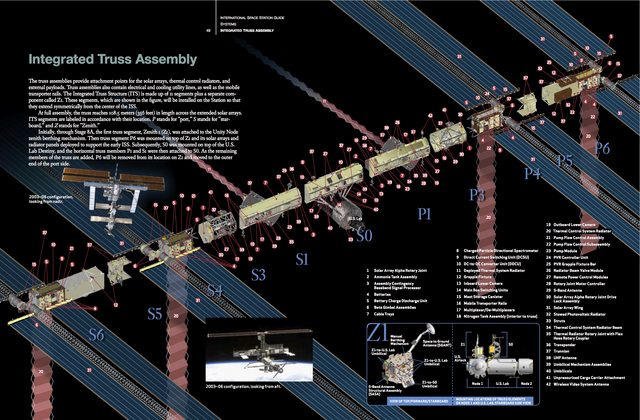Loading AI tools
From Wikipedia, the free encyclopedia
External stowage platforms (ESPs) are key components of the International Space Station (ISS). Each platform is made from steel[citation needed] and serves as an external pallet that can hold spare parts, also known as orbital replacement units (ORUs), for the space station. As a platform it is not pressurized, but does require electricity to power the heaters of some of the stored equipment. ORUs are attached to the ESP via Flight Releasable Attachment Mechanisms (FRAMs), matching witness plates that mate the ORU to the platform.

While ESP-1 is unique in shape, ESP-2 and ESP-3 were based on the deployable version of the Integrated Cargo Carriers (ICC), which were designed to transport unpressurized cargo inside the Space Shuttle's cargo bay. ESP-1 was transported to the International Space Station on STS-102, ESP-2 flew on mission STS-114 'Return to Flight' and ESP-3 on mission STS-118.




The first of the external stowage platforms, called ESP-1, was installed on the port side trunnion pin on the outer hull of the Destiny Laboratory Module on March 13, 2001 during the second EVA of the STS-102 Space Shuttle mission.[2] It is powered by the Unity Module and has two attach points to store ORUs.
ESP-1 was carried into orbit on the underside of an Integrated Cargo Carrier. It is smaller than the other ESPs and ELCs, with dimensions approximately 0.46 m wide by 2.4 m long, and is differently shaped.
ESP-1 holds the following ORUs:[3]


ESP-2 was detached from its Keel Yoke Assembly (which remained in the Orbiter) and installed with the assistance of Space Shuttle Discovery's robotic arm and two spacewalkers during the STS-114 mission.[6] It is much larger than ESP-1 with eight FRAM sites creating room for up to eight spare parts (ORUs). Like ESP-1, it is powered by the Unity Module. However, unlike ESP-1, ESP-2 is attached to the Quest Joint Airlock using a specialized ESP Attachment Device (ESPAD). ESP-2 and ESP-3 are deployable versions of the integrated cargo carrier and have the same dimensions, approximately 8.5 feet (2.6 m) long and 14 feet (4.3 m) wide. The ORUs on ESP-2 are:
Notes:


ESP-3 was detached from its Keel Yoke Assembly (which remained in the Orbiter) and installed on the P3 Truss at UCCAS-1 on August 14, 2007 during the Space Shuttle STS-118 mission. It has seven attachment sites for ISS spare parts and assemblies, called Orbital Replacement Units (ORUs). The platform also has handrails and attachment points for tethers and foot restraints that astronauts can use while working with the ORUs on the ESP-3. ESP-3, as with ESP-2 are deployable versions of the Integrated Cargo Carrier and have the same dimensions, approximately 8.5 feet long and 14 feet wide. ESP-3 has two grapple fixtures to aid deployment.
ESP-3 was the first major station element to be installed completely by robotics, using only the shuttle and station's robotic arms, an external berthing camera system (BCS) and a Photovoltaic Radiator Grapple Fixture (PVRGF). Astronauts robotically installed the platform onto the station's P3 truss segment during the STS-118 mission's seventh day.[15]
On January 12, 2010, the station's robotic arm was used again to move ESP-3 from the P3 truss segment UCCAS-1 site. It was grappled by the arm and then transferred down the station's backbone on the mobile transporter. ESP-3 was then attached to its new location on the lower part of S3 truss segment at the PAS-3 site. Moving the storage platform cleared the way for ExPRESS Logistics Carrier-3 to be installed during STS-134.
The ORUs (currently) installed on ESP-3 are:
Notes:
FRAM-2 originally hosted NTA tank (SN0005) that was launched on ESP-3,[13] it was swapped for the depleted NTA (SN0002) from the S1 truss during STS-124.[18] That failed unit was later returned on STS-126 when the FHRC was placed here.[16]
FRAM-3 hosted Pump Module (PM) SN0006 that was added by the STS-127 crew.[17] The ISS Exp 38 crew swapped PM SN0006 with the failed PM SN0004 from the S1 Truss during 2 EVAs Dec. 21 and 24, 2013, leaving PM SN0004 on the MBS ORU POA for later storage. It was eventually (in Oct. 2014) stored on ESP-2 FRAM-1, rather than ESP-3 FRAM-3.
FRAM-4 hosted a CMG & frame and both were removed Aug. 13, 2007 during STS-118. Support frame was placed on ESP-2, CMG was installed in the Z1.[13] The failed CMG was placed on the CMG frame on ESP-2 FRAM-5 and later returned to earth by STS-124.

Seamless Wikipedia browsing. On steroids.
Every time you click a link to Wikipedia, Wiktionary or Wikiquote in your browser's search results, it will show the modern Wikiwand interface.
Wikiwand extension is a five stars, simple, with minimum permission required to keep your browsing private, safe and transparent.